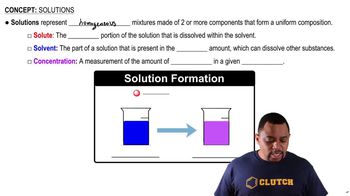Here are the essential concepts you must grasp in order to answer the question correctly.
Mass Percentage
Mass percentage is a way of expressing the concentration of a component in a mixture. It is calculated by taking the mass of the solute (in this case, ascorbic acid) and dividing it by the total mass of the solution (solute plus solvent), then multiplying by 100 to convert it to a percentage. This concept is essential for understanding how much of a substance is present in a solution relative to the total mass.
Recommended video:
Density
Density is defined as mass per unit volume and is a critical property of substances that can affect calculations in chemistry. In this context, the density of the solution (1.22 g/mL) can be used to determine the volume of the solution, which is necessary for calculating the mass percentage. Understanding density helps in converting between mass and volume, especially in solutions.
Recommended video:
Solution Composition
The composition of a solution refers to the relative amounts of solute and solvent present. In this case, ascorbic acid is the solute, and water is the solvent. Knowing the composition is vital for calculating various properties of the solution, including mass percentage and molarity, which are important for understanding the behavior of the solution in chemical reactions.
Recommended video:





